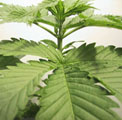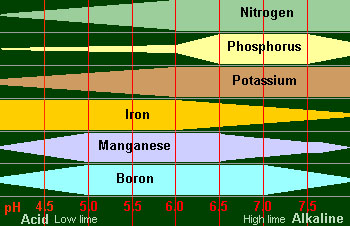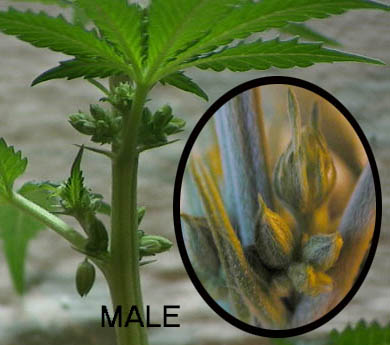|
:: navigate ::
:: news
:: gallery
:: gardens
:: forum
:: cultivation
:: visitors page
:: join us
:: about us
:: members
:: chat
:: help
:: bongs
:: links
:: contact us

|
|
|
This is the Growers Guide they currently have at marijuana.com and it was also the best one I could find so have fun and good luck if you try to grow. If there are any mistakes or anything you guys would like to put into this guide please email us at [email protected].
1. Introduction
2. Chosing and Obtaining Your Desired Strain
3. Lighting
4. Germination
5. Vegetative Growth & Flowering
6. Harvest (drying and curing)
7. Outdoor Cultivation
8. Hydroponics
9. Organics
Vegetative Growth & Flowering
 Once your new sprout starts producing leaves, you are in the vegetative growth stage of the plant.
Only water when the soil is dry all the way to the bottom of the container it is growing in. You can
check by sticking a finger through one of the drain holes in the bottom of the pot to feel how wet the
soil is, or by using a water meter. Perhaps the best method, however, is to wait for the plant to tell you
it needs water. The leaves will start wilting slightly and the plant generally looks "thirsty". The reason
this method is preferable to others is twofold � one, you are assured of not overwatering, and two,
allowing the soil to dry out completely stimulates the roots to grow as they search for water. More roots
= a bigger, stronger plant = more & better buds.
Once your new sprout starts producing leaves, you are in the vegetative growth stage of the plant.
Only water when the soil is dry all the way to the bottom of the container it is growing in. You can
check by sticking a finger through one of the drain holes in the bottom of the pot to feel how wet the
soil is, or by using a water meter. Perhaps the best method, however, is to wait for the plant to tell you
it needs water. The leaves will start wilting slightly and the plant generally looks "thirsty". The reason
this method is preferable to others is twofold � one, you are assured of not overwatering, and two,
allowing the soil to dry out completely stimulates the roots to grow as they search for water. More roots
= a bigger, stronger plant = more & better buds.
Probably the most common error for new growers is overwatering. Over watering will cause the plant to
grow poorly, and if continued will lead to root rot and eventual death.
Be careful if you are starting out with a large pot. If you water a small plant too much in a large pot, the
plant may not be able to soak up all that water. It may look dry on top, but you might end up having
mud on the bottom of the soil. This will cause root rot on your plant and is very unhealthy. A plant that
is not watered enough is much more healthy then a plant that is watered too much. It's also harder to
recover from over watering then under watering.
As a rule 1/2 inch of gravel or another suitable, high draining mixture at the bottom of the pot will help
to prevent this problem and will also stop the plant from drowning if it�s over-watered.
It's a good idea to have a fan hooked up and ready to go once the plant breaks though the soil. Having
a fan blowing on the stem from the start of growth will insure a good strong stem so the plant will be
able to hold it self upright during its life span. Simulating wind by providing a gentle breeze will help your
stem grow strong to support the weight of the leaves and buds as the wind will cause small tears in the
plants stem walls, tears that are repaired as the plant grows and provide strength to the main stem.
Bigger, stronger stems = bigger, stronger plant = more & better buds.
It's a good idea to have a fan hooked up and ready to go once the plant breaks though the soil. Having a fan
blowing on the stem from the start of growth will insure a good strong stem so the plant will be able to hold
it self upright during its life span. Simulating wind by providing a gentle breeze will help your stem grow strong
to support the weight of the leaves and buds as the wind will cause small tears in the plants stem walls,
tears that are repaired and provide strength.
 The temperature can be anywhere from the low 70s to the high 80s with no damage to the plants. For soil, the desired pH range is between 6.3 and 6.8 generally speaking. Anything in that range will be safe for your plant.
The humidity should be around 60% for vegetative growth.
During the vegetative cycle feed your plants a high Nitrogen (N) food. There are many kinds of products that
carry high Nitrogen content. It's generally best to start the mixture out at � the recommended dosage and increase the
strength whilst the plant grows and develops in both foliage and root size, overdoing the nutrients at this
point will not make the plant grow faster, but will most likely burn it. For vegetative growth, look for a fertilizer with a NPK ratio of roughly 2-1-1. NPK is the number found on
fertilizer packages that signifies the amount and ratio of the three major nutrients needed by plants:
Nitrogen (N), Phosphorus (P), and Potassium (K). For this stage, then, look for a fertilizer that has
roughly twice as much N as it does P and K.
Now that your plant is around the 12" mark or 4 - 6 weeks old, you might notice the leaves sets start to
alternate. When the top branches start to alternate this is the sign that your plant has reached maturity
and are ready to be flowered
The temperature can be anywhere from the low 70s to the high 80s with no damage to the plants. For soil, the desired pH range is between 6.3 and 6.8 generally speaking. Anything in that range will be safe for your plant.
The humidity should be around 60% for vegetative growth.
During the vegetative cycle feed your plants a high Nitrogen (N) food. There are many kinds of products that
carry high Nitrogen content. It's generally best to start the mixture out at � the recommended dosage and increase the
strength whilst the plant grows and develops in both foliage and root size, overdoing the nutrients at this
point will not make the plant grow faster, but will most likely burn it. For vegetative growth, look for a fertilizer with a NPK ratio of roughly 2-1-1. NPK is the number found on
fertilizer packages that signifies the amount and ratio of the three major nutrients needed by plants:
Nitrogen (N), Phosphorus (P), and Potassium (K). For this stage, then, look for a fertilizer that has
roughly twice as much N as it does P and K.
Now that your plant is around the 12" mark or 4 - 6 weeks old, you might notice the leaves sets start to
alternate. When the top branches start to alternate this is the sign that your plant has reached maturity
and are ready to be flowered
 Since you have your plant in the 24/7 cycle let the plant grow for as long as you like. A plant may double,
triple even quadruple its' height when flowering. Sativas can stretch up to 4 times there height and Indicas
generally double in height. Some strains call for up to 8 weeks of vegetative growth. Your height, yield and
potency will all depend on the strain and the way it was grown. As our aim is for bud, and lots of it, we will
try and avoid massive plants unless we have the light to provide them with, otherwise we get a plant with
huge stems, and only bud at the top 9 or 10 inches.
Since you have your plant in the 24/7 cycle let the plant grow for as long as you like. A plant may double,
triple even quadruple its' height when flowering. Sativas can stretch up to 4 times there height and Indicas
generally double in height. Some strains call for up to 8 weeks of vegetative growth. Your height, yield and
potency will all depend on the strain and the way it was grown. As our aim is for bud, and lots of it, we will
try and avoid massive plants unless we have the light to provide them with, otherwise we get a plant with
huge stems, and only bud at the top 9 or 10 inches.
Remember, you can only get "bud" from a female plant. So you want to focus your efforts on the female
plants. In order to find the sex of the
plant, get a light timer and put the lights on a cycle of 12hours on and 12hours off. Having a light timer is
much easier then doing it manually and is much more accurate. Make sure your plants get the complete
12hours of darkness during this stage. Any light interruption may prolong your sexing results for days or even
weeks. Your flowering stage may take 2-3 months. You need to keep them on a constant cycle and remember
to have complete darkness during the 12 hours of no light. Any interruption may cause reduced yield,
potency, or extended harvest.
 During the flowering cycle feed your plants need a high Phosphorous (P) food. There are many kinds of products
that carry high amounts of Phosphorous. Generally start out the mixture at 1/2 the recommended dosage. The humidity
should ideally be around 40% to 55% for this stage.
During the flowering cycle feed your plants need a high Phosphorous (P) food. There are many kinds of products
that carry high amounts of Phosphorous. Generally start out the mixture at 1/2 the recommended dosage. The humidity
should ideally be around 40% to 55% for this stage.
After a few days to usually 14 days of your 12/12 cycle, look for little white hairs (indicating a female) or
little balls (which will be male) starting to grow at the base of each internode. The hairs will grow to about
1/4" long
or so. They will be easily visible. Expect to see a pair of these hairs at each site. The balls may also grow at
the base of each branch. They will grow in bunches and look a little like horns before forming. These balls
contain pollen. As soon as you have identified what sex your plant is (male or female) then cull the males
(remove them from the area) to give the females more room and more light.
This is the start of the buds forming. As time goes on the buds will get bigger and bigger and they will use
more and more fertilizer. It is advised that you stop using ferts 2 weeks before your harvest to ensure that
all chemicals are out of the plant. If chemicals are in the plant when you harvest, the smoke will be very
harsh. To prevent harshness, flush the plants heavily with fresh water 2 weeks prior to harvesting them.
Ensure you flush at least 3 times the capacity of your pot. So a 4 gallon pot would be flushed with 16 gallons
of fresh water.
You can smoke male plants, but the main focus is the female bud. This is rich with THC and can be very
enjoyable to smoke. Soon you will be harvesting your plant once it has grown to the point where it stops,
and begins to swell and become ripe.
See also:
Lighting ::
Organics ::
Harvest (drying and curing)
|
|
